The effect of plastic film mulching cultivation of spring peanut is good.

In addition to selecting suitable varieties for high yield of spring peanut, cultivation techniques are also very important. The sowing time of spring peanut is generally in the period from "sting" to "the Spring Equinox", when the cold wave is frequent and the temperature is low Rain Water, which is disadvantageous to the emergence and whole seedling of peanut. Popularizing the cultivation technique of peanut covered with plastic film not only overcomes the problems of slow and uneven emergence and difficulty of fully strong seedlings, but also the yield is obviously higher than that of open field cultivation. According to the comparative experiment, compared with open field cultivation, the yield per mu of plastic film mulching cultivation reached 310 Mu 358 kg, and the yield increased by more than 20%. Four main techniques should be mastered: first, fertilization and soil preparation. Plastic film mulching cultivation of peanut is not convenient for topdressing, so sufficient base fertilizer should be applied. When sowing and ploughing, 1000 kg of soil miscellaneous fertilizer, 40 kg of superphosphate and 30 kg of lime were applied per mu as base fertilizer. Then ploughing separately, the soil layer is evenly mixed with fine crushed fertilizer, and the box surface is leveled, with a width of 70 cm and a height of 16 mi 18 cm, and then wait for sowing. Second, broadcast early at the right time. The sowing date can be 7 murine 10 days earlier than that of open field cultivation, and the seedlings can emerge earlier, which is beneficial to early maturity and high yield. In order to prolong the growth period in advance of the season, soaking seeds to promote sprouting and sowing seeds, the whole seedlings came out in 8 days after sowing, which was more than 7 days earlier than that of dry seeds. with the advantage of light source in wide and narrow rows, double seeds were planted in wide rows of 40 cm, plant spacing of 15 cm and holes, sowing about 18,000 seedlings per mu. After sowing, use ash fertilizer to mix appropriate amount of mature barnyard manure and wet sand to cover the seeds. Third, cover the film in time. When covering the film, it should be stretched and paved, close to the ground, and then compacted with soil around the plastic film in order to improve the soil temperature and control the adverse effects such as weed top film and wind blowing. After the peanut seedlings are complete, the membrane is broken and the plastic film around the hole is pressed. The fourth is to strengthen the field management. After sowing, peanuts should be inspected and repaired in time to prevent rodent damage and being exposed and broken by the wind. Let two cotyledons be exposed to sunlight after clearing trees to promote the early growth and rapid development of the first pair of lateral branches, and the lack of seedlings should be used to promote budding and replenish them in time. Generally, there is no need for topdressing, if the phenomenon of weak seedling potential due to lack of fertilizer is found in the seedling stage, potassium dihydrogen phosphate plus 1% urea solution can be sprayed on the leaf for 2 times. Other field management is the same as open field cultivation.
- Prev

Reasonable close planting of spring peanut
For high yield of spring peanut, six technical links must be mastered: 1. Select excellent varieties. Improved varieties are the basis for high yield, and varieties with strong resistance, high yield and high oil should be used first. In recent years, experiments have shown that Shanyou 523, Shanyou 71, Yueyou 79, Guihua 21, Wuyou 7 and other "three high" varieties. When planting, also.
- Next

Plastic Film mulching cultivation techniques of Spring Peanut
The main pests from seedling to flower needle stage are aphids. Control index: there are 1000 aphids in Baidun, and 50% of omethoate is sprayed on 50 kg of water every 667m. Attention should be paid to the protection of natural enemies (ladybugs). When the ratio of ladybugs to aphids reaches 100, ladybugs can be used to prey.
Related
- The first cup of black tea in spring, the flavor and history of tea gardens in Kenya, Africa
- The computer can not only choose potatoes, but also grow tea rice. AI will grow winter oolong tea champion.
- It is not only the inflated tea bitten by insects, but also engraved with the four seasons tea in Beipu.
- The Oriental Beauty Tea Festival in Zhuxian County takes the stage at the weekend to experience the plus-size feast of oil tea.
- & quot; Oriental Beauty Tea & Exploration of Emei in Hsinchu, the hometown of quot;
- The new variety of strawberry "Tainong 1" dessert is the first choice with mellow aroma. Crimson gorgeous
- History of Tea in Taiwan: from Wild Inner Mountain to Export Tea Garden
- Two types of Taiwan Oriental Beauty Black Tea won the British three-Star Award for Childhood Tea Xiang Zhang Jiaqi changed from pilot to champion tea maker.
- Banana species and varieties: the planting history of Taiwan Xianren banana and dwarf banana is long, is banana disease resistant?
- Coffee planting Technology: Qianjie Coffee from Seedling to harvesting

